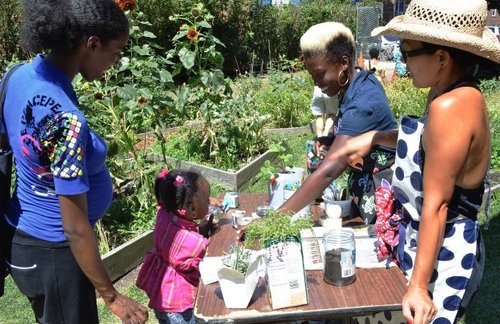Con Edison Immigrant Artist Program Newsletter, Issue No. 30
Featured Organization: The Weeksville Heritage Center (WHC)
The Weeksville Heritage Center (WHC) documents, preserves and presents the history of the community of Weeksville, a town that flourished with a population of more than 500 free blacks, including doctors, teachers, and landowners, prior to the Civil War. As one of the first free black communities in the United States, Weeksville is a nationally historic site situated within the Bedford-Stuyvesant/Crown Heights area of Brooklyn. WHC, an institution rooted within the traditions of African American history, charges itself with engaging audiences through innovative programming that both references the past and offers modern and relevant learning experiences. The qualities of independence, entrepreneurship, and community activism embodied by the residents of historic Weeksville inform and inspire WHC’s programs today.
The grass-roots cultural center runs a seasonal farmers market and offers urban gardening, visual and performing arts, and other traditions of the past community. Partnerships with other cultural centers in the area provide WHC’s staff and constituents opportunities for experimentation and new learning. One example is the event Seeding the City: Learn How to Live Green in the City, a collaboration held in July 2011 between WHC, The Laundromat Project, and NYFA’s Immigrant Artist Project. This event was a day full of workshops and demonstrations focused on environmental awareness, food cultivation, and urban beautification, which offered artists, farmers, and food activists opportunities to teach and learn from each other.
In October 2009, the center began the construction of a new, 19,000-square-foot education and cultural arts building, which is expected to receive LEED certification, an internationally-recognized credential that declares the building environmentally efficient. It’s expected to open in early 2013 and offers an exceptional opportunity for WHC to increase focus on research and expand and improve its existing programs. NYFA Program Associate Michon Ashmore interviewed Elissa Blount-Moorhead, WHC’s Vice Director/Director of Design, Programming, and Exhibitions, about the organization’s roots, its place in the contemporary local community, and its plans for the future.
IAP: Weeksville was a free black community whose residents owned property, ran their own businesses, and established churches, schools, and a hospital during a time when slavery was still a prominent practice. How do you use this story to inspire and empower the local residents today?
WHC: Essentially, we try to use these powerful examples of intellectual and creative freedom to reference past ways of being and also “activate” history for modern audiences. It is important to WHC that our narrative is relevant to current audiences and current concerns. For example, we use our kitchen garden to illustrate examples of self determination in the 19th century, while simultaneously discussing modern food sovereignty, botany, and local nutrition to school children through our Green Weeksville program.
IAP: In addition to focusing on history and preservation, WHC also incorporates visual arts, performance and cultural events into its programming. Why do you consider it important to do this and how do these types of events develop a greater understanding of historic Weeksville?
WHC: We consider the visual arts one of our most important vehicles to work with our community on civic engagement and social change. Self crafting and creativity is part of the spiritual bedrock upon which 19th-century Weeksville was built (as well as the recent 40-year preservation effort that created the current Weeksville organization). We often talk about the fact that Weeksville’s unique history represents an “erasure” in black history curriculum taught in schools, which usually focuses on struggles such as slavery and the civil rights movement of the mid-century. Many lessons focus on heroes of these struggles rather than the everyday lives and beauty of people living in post emancipation NY. We think that visual art is an effective tool to bring to life the idea that black people aren’t always living in “opposition” to the world around them but are often contributing to their own communities while also serving their specific need to create beauty and harmony through the arts.
Much of our photographic collection has enabled us to help visitors imagine a slice of 19th-century free black lifestyles for the first time. Needless to say, visual arts are a powerful way for contemporary visitors to document their perspective on their lives and understand that Weeksville residents also did the same thing in their lives, as evidenced in work from Richmond Barthé located in the nearby Kingsborough Housing Development. It’s a window into history, art making/practice, and aesthetic sensibilities of this community. We are using our media and literary arts programs to lend a similar voice to teens today. Our contemporary gallery for the built environment, artists live-in residency, and public art programs (for more details on these programs, please click here) are also being designed to provide platforms for professional visual artists to continue to interrogate the landscape in which WHC exists today and make a commentary visual through publication, exhibition, and public installations.
IAP: Innovation, the vanguard, and the subversive are often featured characteristics in the work of the artists and performers you choose to present at WHC. How do these themes demonstrate the organization’s core values and mission?
WHC: These themes ARE the core values of WHC. Some of our thematic threads and core values, such as irreverence, subversive, beauty, luminosity, humor, and transformation are what help define what we do and how we do it. We extract these themes from what we know about the people who created this place. We learn from their written and oral histories, primary documents, and domestic objects that these were values that they shared. We, as staff of WHC, feel that we are simply stewards and interpreters of their vision of a life well-lived. They are the vital underpinnings of our program development criteria. Nothing would gel here or make any sense in terms of mission relevancy if we didn’t honor these historic findings and match them to our modern audience needs and desires.
IAP: WHC runs an urban gardening program and seasonal farmers market. Can you tell us about this program, including its origins and goals? What factors made you want to focus on sustainability at WHC?
WHC: Our farmers market was started in 2005 by one of our researchers with a food sovereignty view. Our kitchen garden and farmers market are directly linked to the narrative that Weeksville uses to teach students and adult audiences about Brooklyn’s agricultural past and its African American foodways and traditions.
WHC is located squarely in what is now referred to as a food desert, and access to fresh produce and healthy food options is at the core of many of the nutritional issues that our local community faces here. In an attempt to provide openings to discuss and bring to life modern connections to 19th-century traditions (such as canning, heirloom seeds, medicinal herbs and urban agriculture), we also provide demonstrations and workshops along with our market.
IAP: How does this program reach out to immigrant communities?
WHC: We are planning (when we open our new center) for bilingual materials and instruction. We now cater quite a bit to our closest (geographically) immigrant audience, which is from the Caribbean, through recipe exchanges, food related events, concerts in the garden, and other family-related activities. Our farmer’s market manager Ola Akinmowo has worked closely with our teen training programs, which we are planning to expand this year.
IAP: What impact has this particular program had on your constituents so far?
WHC: The impact has been tremendous for both us and our local communities. We accept health bucks, FMNP, and WIC at our market, so we are able to serve our constituents who receive public assistance but want to have healthy choices for their families, especially mothers of small children and senior citizens. Also our ancillary programs such as recipe exchanges give us an opportunity to really “fellowship” with our community and share good food, which is always a connector across all cultures.
IAP: WHC partners with other organizations from time to time to exchange ideas and present new events and programs. How does this type of collaboration enrich the local community and the experience of WHC visitors?
WHC: It is immeasurable. Collaborations such as Seeding the City: Learn How to Live Green in the City, with The Laundromat Project and NYFA’s Immigrant Artist Project, open us up to new ideas but also new teaching artists and their fresh modalities. Collaboration allows us to experiment and let go of any rigidity or “know it all-ness” that may creep into our process. We always learn new and interesting ways of doing things and partners always bring new eyes to our site! In the future we are expanding our partnerships immensely to include some “surprising/unlikely” partners as well as ones that we have been dying to work with for years.
IAP: You’re in the middle of constructing a $30 million extension for the Heritage Center. What are your plans for the new building?
WHC: This is probably the most exciting and intimidating part of our lives right now! The 19,000-square-foot LEED Gold building will add 2 media lab/classrooms; a 200-square-foot performance space; a contemporary gallery; retail and eating space; an oral history studio; workshop space; and a new resource center. We will be unveiling some of the specific plans this year (we open in the first quarter of 2013). Most of what we will do is expand and improve existing programs such as our popular school tours, which will now include digital elements; our kitchen/botany learning garden will be expanded to include livestock and more demo gardens; our arts preservation program will add an international component; and our performance slate will now include dance, film and theater in addition to concerts!
Clearly the building allows us to do new and exciting projects as well, the most important of which is the launch of our Resource Center, which serves as the intellectual heart of the entire campus and provides the content underpinnings for all that we do in programming. It is being headed by Jennifer A. Scott, who has plans that include extensive symposia, oral history projects, resident scholar programs, a jazz research project, and visual storage. We are also expanding our green and visual arts offerings. Our new gallery will house a contemporary visual arts program, a public art project, and a live-in artist residency.
IAP: How can artists, activists and anyone else who is interested become involved in your programs?
WHC: The best thing to do is to sign up to become members and/or join our mailing and volunteer lists, letting us know what your interests may be. As we put out calls for work, advisory boards, presenting opportunities and other news we will be able to send information to you based on your interests. Call Esther Alix at (718) 756-5250, ext. 314 if you want to become involved.





